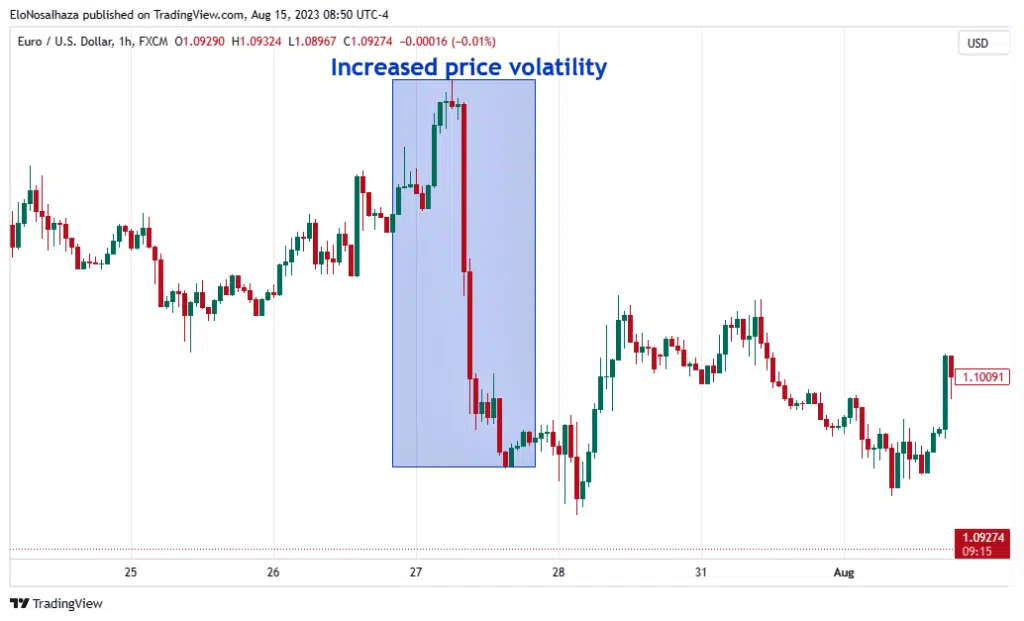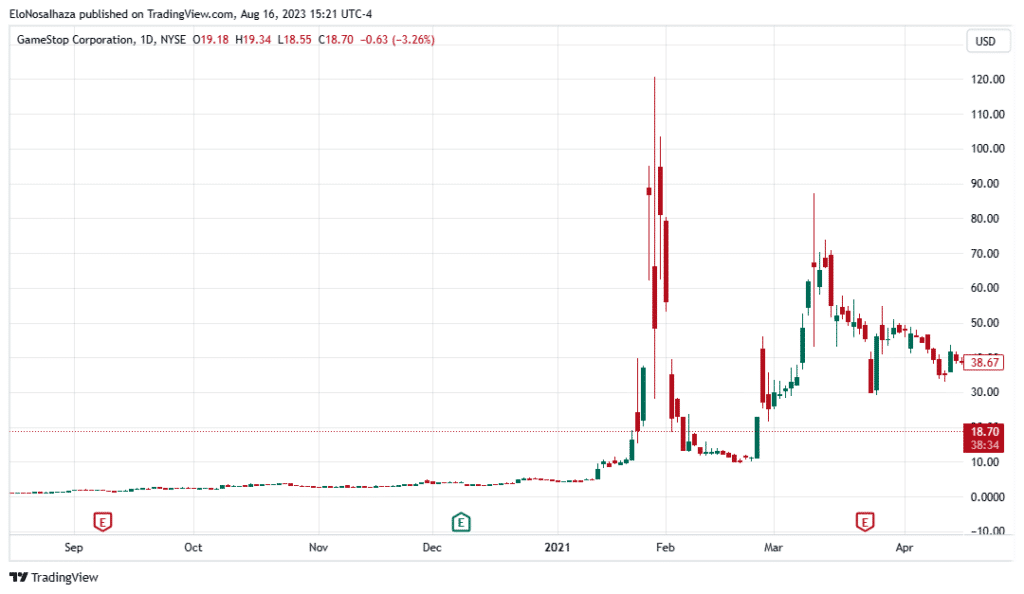No doubt, every trader has experienced periods of increased doubt with price forecasts. They are usually during high-volatile conditions, especially with no clear up or downtrends.
Thus, learning and preparing yourself with this article will give you a solid edge. It shares factors influencing such conditions and how to tackle them smartly.
Table of Contents
1. What Is Market Volatility?
The term “volatility” has long been thrown around within and outside the financial space. It hardly connotes anything positive in most cases. However, it’s even more essential to understand its meaning as an aspiring trader.
Market volatility refers to the degree of price fluctuation in any financial instrument. An asset with more sudden price changes in a specific period is said to be highly volatile. Conversely, those with stabler price movements are only slightly volatile.
Most traders prefer the latter to amass and maintain potential profits, but it’s never always the case in the markets.
Volatility is specific to an instrument; relative to its past actions. If interested, you can explore Investopedia to learn how to calculate it effectively.
PS: When any trader only uses the term “volatile” or “volatility,” they’re usually referring to “high volatile” or “high volatility” conditions.
1.1 Sample Cases of High & Low Volatility In Price Charts
Since you’ll avoid or engage the market based on the underlying volatility level, gauging it in price charts is crucial.
Experts may only need a glance to make informed decisions. However, it’ll become second nature to newbies after studying several case scenarios, like the following:
1.1.1 High Volatility: EUR/USD H1 Chart
Between 26 and 27 July 2023, the EUR/USD experienced significantly increased volatility. It quickly broke old highs before massively falling in the one-hour chart.

1.1.2 High Volatility: XAU/USD M30 Chart
The commodity market also experiences high volatility periodically, as seen in the Gold-USD chart below.

The price quickly moved in both directions on different occasions in the first week of August 2023.
1.1.3 Low Volatility: S&P 500 W1 Chart
From 2016 through 2017, the S&P 500 maintained a steady bullish movement. There were a few drawbacks, but none was erratic enough to disrupt the relatively low volatility on the weekly chart.

1.1.4 Low Volatility: BTC/USD H1 Chart
The crypto market can also experience low volatility in range-bound conditions, as in BTC/USD 7-10 July 2023.

Scalpers are popular exploiters of price’s failure to make sudden movements that break consolidations.
2. Factors Influencing Market Volatility
There’s barely any top trader that enjoys price volatility. It decreases the likelihood of your forecast panning out, possibly resulting in losing trades.
Fortunately, you can anticipate and prepare for them, as experts have shown.
It entails understanding factors responsible for them, like the few discussed below:
2.1 News Reports
News reports have always influenced price volatility. Hence, following your favorite providers can encourage or steer you clear of such periods.
The releases may be breaking or anticipated on almost every topic across online and offline sources. Strive to be on your toes, provided there is any link to the financial markets.
The “GameStop Short Squeeze” incident in 2021 is an excellent example.

Rumors to drive the stock price (spread from Reddit) caused significant market volatility, surging from $20 to $300 within days. It also reportedly affected several stocks, cryptocurrencies, and metal futures.
2.2 Economic Data Releases
You’re likely experienced with this if you’ve been trading for a while now.
Generally, the financial markets react to an economic data release with increased volatility. Some experts even argue that major ones drive preliminary reactions.
Popular recurring releases include GDP output, interest rate change, and unemployment data, depending on your location and instruments traded.
For example, the NFP report is among the most anticipated in the United States. It occurs every first Friday of the month, affecting several markets.

2.3 Natural & Geopolitical Events
Several real-world events can wittingly & unwittingly influence market volatility. It could be elections, military coups, earthquakes, increased harvests, etc.
However, unlike economic reports, they’re more challenging to expect and even foresee their potential impact. You may need to up your fundamental analysis game to benefit from them.
Rookie traders also rely on several independent analysts on social media for interpretations.
You can also stay away from markets such events may potentially impact. Better safe than sorry.
3. Risk Management Tips in Volatile Markets
Volatility is an innate quality of price. It may be less in some markets than others, but you can’t completely escape it as a trader.
Instead, you can employ several risk management techniques to lower the odds of losing trades. Here are some to consider:
3.1 Diversification
Diversification is one of the most promoted ways to reduce risk in the financial world, and it’s also effective during high volatility.
It involves spreading your investments across several assets, industries, and geographical regions. Better-performing instruments should help cushion the losses from underperforming ones.

That said, there is never any guarantee of safety after diversification. The markets are always full of surprises (especially for newbies).
Furthermore, experts see diversification as a long-term strategy. It won’t be as practical for scalpers and day traders as for swing trading.
3.2 Trading Lower Time Frames
Depending on your trading strategy, using lower time frames than accustomed to usually lessens the risk. You’ll be free to operate how you typically would with the candlesticks.
However, the stop losses will be tighter, and the price fluctuations will reveal themselves quicker.
Admittedly, there’s more tension and urgency if you’ve always used the higher time intervals, but it’s arguably better than the despair from losing larger funds.
3.3 Setting Correct Position Sizes, Stop Loss and Take Profit Levels
Increased volatility means increased risk. There’s no sugar-coating the fact.
Hence, your position sizing and orders should reflect this.
During such periods, don’t overleverage and lean towards a lower position size when taking trades. The final figure will depend on several factors, like your broker rules, but ensure it is less than usual.
Also, consider tightening your protective stop loss and take profit levels until the market becomes less volatile.
4. Strategies for Navigating Volatility in Trading
You always want all your trades to be successful, even during volatile times. Luckily, there are a few tested and trusted techniques.
When it happens during consolidations, simply anticipate and trade the possible breakout. You can’t always be sure of the direction, so it helps to monitor the charts closely during the period.
Traders have also exploited volatility-induced mispricings in related assets. It is known as volatility arbitrage.
Nonetheless, the most recommended way to navigate volatile markets is using the Linear Regression Channel for TradingView.

It provides high-probability support and resistance levels in real-time. Thus, despite the inconsistent price fluctuations, you still have a solid expectation of where lows and highs will form.
The indicator always moves with price, with 95 percent of all price action occurring within the orange lines.
Here are some standout benefits you’ll enjoy from it:
- Freedom to trade trends or reversals
- Ease of nailing significant highs and lows at an increased probability
- Ability to use it on swing or day trades in all financial markets
- Improvement of any trading strategy
5. Final Thoughts
Market volatility was and will continue to be a price phenomenon due to several influencing factors discussed in this article.
Trading during such periods is easier said than done. Regardless, some risk management tips, like diversification and opting for lower time frames, will keep you safer.
For the best signals, use the Linear Regression Channel for TradingView.
You can share this article with friends and close ones to help improve their trading expertise and decisions. Remember also to join the engaging discussions in the comment section.





